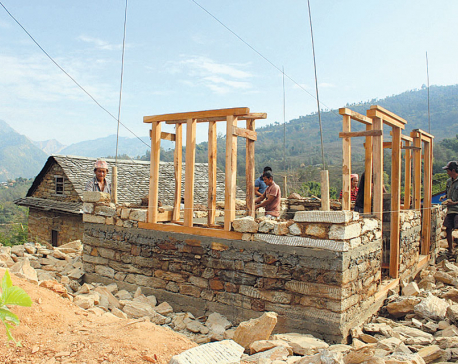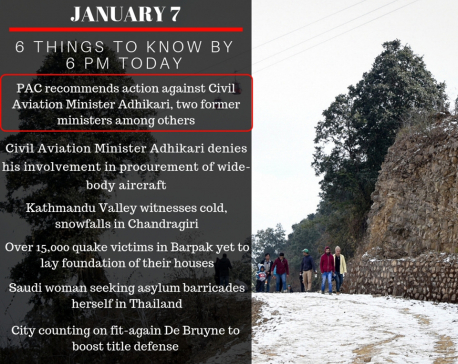
OR
Nepal faces the threat of a much stronger earthquake with magnitude of 8 or more, scientists say
Published On: January 19, 2019 01:00 PM NPT By: Agencies

More than three years after being hit by a powerful tremor, Nepal still faces the threat of a much stronger earthquake with magnitude of eight or more, according to a new study by scientists from ETH Zurich.
In April 2015, a tremor of magnitude 7.8 devastated hundreds of village, monuments and traffic routes in Nepal, killing over 9,000 people. The tremor ruptured a 50-km-wide segment of the Main Himalayan Thrust fault system, causing significant damage in Nepal's capital Kathmandu and areas surrounding it.
According to scientists, Nepal sits at the point where two continental plates - the Indian and Eurasian - meet. The Indian plate subducts into the mantle below the Eurasian plate, exerting a suction effect, which causes the Indian subcontinent to move north by up to four centimetres per year.
As a result of the plates rubbing against each other over the 2,000km-long fault line, a significant amount of stress builds up along the fault line. When this stress is abruptly released, displacement of plates occurs, resulting in earthquakes in regions around Nepal and the southern foothills of the Himalayas.
In the current study, researchers used a new computer model to study the collision zone between the Eurasian and Indian plates located close to the Himalayas, and carried out high-resolution simulations of tremor cycles in a cross-section of the rupture zone.
The findings revealed that the Nepal earthquake reduced the stress only in part of the rupture zone, and the stress actually swelled in the frontal section near the foot of the Himalayas.
"In the 2015 quake, there was only a partial rupture of the major Himalayan fault separating the two continental plates," said Luca Dal Zilio, a doctoral student and the lead author of the study.
He continued: "The frontal, near-surface section of the rupture zone, where the Indian plate subducts beneath the Eurasian plate, did not slip and remains under stress."
The simulations also suggested that the current build-up of stress could be enough to cause a powerful earthquake of magnitude 8.1 or more in the near future. Such a quake would lead to a complete stress release in this specific segment of the fault system. That earthquake would break the rupture zone over the entire depth range and would extend up to the Earth's surface.
While it is impossible for researchers to predict the exact month, year or decade for the looming earthquake, understanding the threat is vital to get protection in place to save the lives of millions of people living in the Himalayan region.
"No one can predict earthquakes, not even with the new model. However, we can improve our understanding of the seismic hazard in a specific area and take appropriate precautions," said Edi Kissling, Professor of Seismology and Geodynamics.
The findings of the study are published in journal Nature Communications.
You May Like This

Post-quake reconstruction to be completed in 2 years: NRA chief
KATHMANDU, Jan 11: Chief Executive Officer (CEO) of the National Reconstruction Authority (NRA) Sushil Gyewali, has said that the ongoing... Read More...

Jan 7: 6 things to know by 6 PM today
Your daily dose of missed important news of the day. ... Read More...




Just In
- MoHP cautions docs working in govt hospitals not to work in private ones
- Over 400,000 tourists visited Mustang by road last year
- 19 hydropower projects to be showcased at investment summit
- Global oil and gold prices surge as Israel retaliates against Iran
- Sajha Yatayat cancels CEO appointment process for lack of candidates
- Govt padlocks Nepal Scouts’ property illegally occupied by NC lawmaker Deepak Khadka
- FWEAN meets with President Paudel to solicit support for women entrepreneurship
- Koshi provincial assembly passes resolution motion calling for special session by majority votes







_20220508065243.jpg)






Leave A Comment